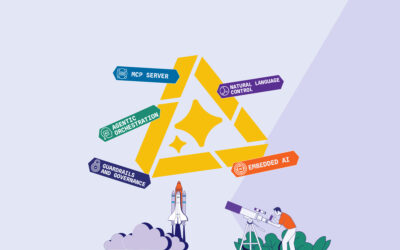Against the backdrop of a global pandemic, insurers are doubling down on their commitments to digital transformation. Robert Mulligan, president and CEO of Renaissance Life and Health Insurance Company of America, and Guardian Group’s technology leader for product and claims Chip Bunker participated in a discussion led by Mike Connor, CEO and co-founder of the Silicon Valley Insurance Accelerator, and facilitated by EIS EVP of worldwide professional services Jim Caruso.
On March 19, 2020, Californians were confronted with statewide shelter-in-place orders in response to the COVID-19 global pandemic. Businesses were shuttered and travel came to a halt. Other states and nations quickly followed suit. We had officially closed our offices more than a week prior. For me, this was like standing on the seashore and watching a rogue wave grow bigger, knowing it soon would hit.
Unlike many businesses in the United States, EIS was prepared. We’d been watching closely since January, as we were implementing a system in Taiwan. That’s when we got the first indications of the severity of the outbreak and its potential impact on our customers, and our business, worldwide.
As a global software provider, with employees and customers on multiple continents, our implementation approach is a blend of face-to-face and remote work. In many ways, the changes we made were not dramatic. After all, our entire business is about transforming the insurance business via digital technology.
Watch Video: Managing Digital Transformation Remotely at Scale: Jim Caruso from EIS on Vimeo.
Even with the imposition of travel restrictions, we have kept those programs going. We reviewed and updated our business continuity plans, checked on our employees, and informed our customers of our capabilities and intentions.
Interestingly, the pandemic caused the bulk of our customers to accelerate their digital transformation projects. We decided to speak with some of them about managing digital transformation in the context of COVID-19, how they formulated their response priorities, and to share their lessons and recommendations.
The discussion below has been edited for length and clarity.
Mike Connor: What was the situation on the ground when you first knew that you had to go remote?
Robert Mulligan — I’m sure I’m not the first person during this period to use the famous Mike Tyson quote: “Everybody has a plan until they get punched in the face.” That was certainly the case for us.
We made the decision and within three to four days, we transitioned out of our physical office spaces to a remote setup. Our first priority was the health and safety of our employees. Then we needed to make sure our workforce was able to carry out their tasks. About 65-to-70% of our workforce was able, and set up with equipment and capacity, to work from home.
We needed to make sure checks were being cut, and that claims were paid. We knew questions were going to come in fast and furious; we were a 100% domestic call center based in Indianapolis working out of a single facility. We ordered a significant number of lime-green gaming headsets. That was some of the on-the-fly decision making we had to do to get equipped.
We immediately set out to understand what the financial impact was going to be to our business; and how we are going to manage the business in two to three-week increments. We set up a daily senior leadership crisis management team call. And so far, so good.
Watch Video: Managing Digital Transformation Remotely at Scale: Robert Mulligan from EIS on Vimeo.
Chip, you guys came into this from a very different perspective. I’d like you to give a little bit of background on where you guys were.
Chip Bunker — Our journey really goes back to 2012 with Hurricane Sandy, which resulted in three subterranean floors worth of seawater in the building, which shut the building down for a year. We were able to keep continuity of business, but it taught us that we needed to sharpen up.
A couple of things came out of that. One is Guardian on the Go, our remote work capability. There are basically three levels of it: people who work mostly in an office; people like myself who are considered “mobile campus” employees; and people who work from home on a permanent basis. That structure really helped us a lot.
For me, the first three weeks felt a little bit like I was under house arrest. I struggled where the boundaries were: like when to start when to stop. It just feels like your days blur together when you’re 24-7 in front of a screen.
Where we had less preparedness was at our remote call centers. One of them is in the Philippines, and the government shut down call centers fairly early on. We had to assume workload into our domestic call centers. It was fine, but we could have been more prepared.
The other thing we saw was a sharp spike in call center demand. Our business is focused on the leave-of-absence space. So, some of our larger customers decided that they needed to issue changes in their leave policy, and when you’re talking about a hundred-thousand-plus leave cases, it drove a very sharp spike in terms of demand.
Watch Video: Managing Digital Transformation Remotely at Scale: Chip Bunker from EIS on Vimeo.
Conversely, we saw sharp declines in other areas. The American Dental Association basically has shut down dentists except for emergency procedures, so we’ve seen a sharp fall-off in claims. We were able to mix some of those resources and direct them at the hotspots.
What was the status of your digital transformation when this went down, and what response mechanisms have you put into place?
Chip Bunker, Guardian — Our direct-to-consumer business isn’t intended to be a digital-only business; the experience is self-service. That went into production in May of 2018. What we’ve learned in this COVID pandemic is to accelerate our journey. We’re no longer able to do a lot of the physical things that we were able to do before, and require more of a digital experience.
I had this conversation with my dentist’s office manager. I asked her why she didn’t submit more claims electronically. Her response was that it’s just as simple for her to stick the form into an envelope and mail it. For us, receiving that form means opening that envelope, scanning that document, rekeying, and all that. And a very large percentage of our claims come in a physical form despite our best efforts. The other side includes things like explanation of benefits, where there are outbound requirements, and mailing checks to dentists for their claims. We need to push harder on the digital. Even if there are cases where you need to do something physically, having the capability to support a fully digital experience is very important.
Robert, where were you at from a digital transformation standpoint, what was underway with you guys?
Robert Mulligan — We were probably rounding the corner and heading for home; and the first thing many of us thought was “we can’t let this fail.” We cannot carry forward if we don’t transform the way we operate. My panic subsided when I started to realize our processes and teams already were largely virtual.
My biggest concern was making sure product owners were working with GIS on our digital transformation, and had the tools and capabilities to run their departments. We’ve been able to increase the velocity of our project now that we’ve been able to attend to the basic needs. Business is slower, and we’ve been able to channel excess capacity into our initiative.
We’re also beginning to identify other areas that could benefit from digital transformation. We’ve been very successful in convincing vendors to accept electronic funds from us. We had to explain that our check capacity right now is on a two-and-a-half-week cycle, but if you want to get paid faster, signup for electronic funds. Across our entire business, we’re identifying things like that.
How did you go about thinking through what your priorities were? What was the process?
Robert Mulligan — We quickly determined that there was no set of circumstances where we could really stop (our digital transformation). The bigger issue was: what else in our business was going to be impacted?
We were in the midst of a fairly significant office relocation. We have additional space — about 30,000 square feet — that was under construction. We had to understand whether that could continue and, if we’re coming back to work, what does that mean?
We started convening a daily senior team meeting. What we’re learning is that communication, internally and externally, is really a top priority. We’re a 50-state entity, and regulatory directives are coming out fast and furious across the country. So, we had to tap into our experts to make sure we attended to all of those product needs, especially in a disability product environment.
As it relates to customers, call times were escalating. We had to make sure our communications team and our marketing VP and his team were able to get the right message out through every channel possible: ‘If your call times are unacceptably long, send us an email.’ We’ve been able to redirect a lot of personnel to assist with email inquiries, and we have a better response time on that.
We’re figuring out which priorities we need to dial back, and what we have to focus on. We immediately started distributing the metrics to all of our leadership team. We hadn’t done that previously. What are the call volumes, claim volumes, and what does cash flow look like? What are terminations looking like, and how do we respond to customers who have policy questions about renewals and claims? But we’re still moving forward with our transformation. And that’s a really big success story for us.
Chip Bunker, Guardian — At the end of the day, we fall back on our values, and that’s one of the things that I really love about Guardian. Our first value is ‘people count.’ Our second value is: ‘we do the right thing.’ We looked at making sure our customers and our regulators are taken care of through constant communication and figuring out how to do the right thing.
We’ve looked at providing incentives to providers until we get back into the normal swing of things; ways to ease the burden. If you can’t access your dental product for the first half of the half of 2020, for example, do we want to forgo some plan maximums or waiting periods, or provide premium holidays for our plan holders? And ways to strategically use our technology. If you look at our direct to consumer business, there’s a built-in component in the billing engine to do a moratorium. Or, if you want to keep policies from lapsing due to non-payment, you can set that up.
What were the considerations as you determined how to manage projects remotely, and what tools are you using?
Robert Mulligan — The first thing was to establish a communications cadence. That’s what spurred our daily 10:15 huddles. We were fortunate to have Microsoft Teams, so that facilitated our ability to do that on a daily basis. I had been a bit hesitant about doing a video message to all employees. There’s a part of me that thought it was a bit hokey. But I’ve been struck by how positive the response has been from the workforce in general.
Chip Bunker — When we come out the other side of this, I don’t think it’s back to normal. The world has fundamentally changed, and our eyes have been opened on several areas we didn’t think were possible before.
We practice Scaled Agile Framework: the SAFe methodology, and I think that has helped us — from a program management perspective — to juggle different priorities at a moment’s notice. That happens day in and day out; it’s built a muscle memory for us. If you’re familiar with the SAFe methodology, there’s a couple of cadences that are important. As you’re planning for the next 10, 12, 13 weeks, depending on how you run your schedules, that has fundamentally changed. Those were a combination of on-site and off-site participation and they’re 100% virtual at this point.
We don’t force people to sit in front of the screens for four or five continuous hours, we split them up. What we were normally able to do in a couple of days, we now take three or four days. We’re also applying some additional tooling. We’re an Office 365-enabled organization, so Skype teams are part of our normal day-to-day operations. Another thing we’ve used successfully is Microsoft Hub devices that allow you to whiteboard, and Surface tablets allow us to have a more collaborative interaction, which feeds into that whole program management piece.
What’s one of the COVID-related changes, challenges, risks, or priorities that caused you to realign your digital transformation priorities?
Chip Bunker — It’s important for people to understand that our objective is not to just survive. Our objective is to thrive. We haven’t lifted our foot off the pedal on any transformational initiatives. Yes, there has been some change in prioritization, in our claims area for our worksite products, dental and vision, for example. And thinking about how to handle some of these offsets, and the fact that some people are not able to access the service. But they’re not huge impacts on what we’re trying to deliver as an organization.
Robert Mulligan — This situation has reinforced our overall mission: to be easy and accessible, especially in a crisis situation. We’re just figuring out how to be a better business: taking care of employees, taking care of customers, then focusing on the financials. The biggest question I had for my leadership team was what’s going to happen in three, six, and 12 months? There are a lot of variables.
My chief operating officer and his team put together a modeling tool that had upwards of 100 variables to help us assess: what are the worst-case, best-case, and most-likely scenarios. This tool that they’ve developed is something we’re going to use through this crisis and on an ongoing basis. We don’t know the answers, or how customers are going to react. Across products, we don’t know what’s going to be the impact, but we can start thinking about a plan for it.
What surprises, lessons, or recommendations do you have?
Chip Bunker — For me the lessons learned is: communicate. You can’t overdo it. Not only to your internal folks, but to your stakeholders, partners, and regulators.
We focus a lot on employee engagement, we actually measure it, and since early December engagement scores have actually gone up. That’s a function of communicating and people understanding what we’re trying to do as an organization.
For us, engagement is about autonomy, mastery and purpose. And so if you can connect those three things with people, and have them understand how they play a role, it’s hugely beneficial. Lastly, whether you call it a transformation initiative or a digital journey, we’re not going back to where things used to be. We need to keep the momentum and accelerate more aggressively than we have in the past.
Robert Mulligan — I certainly would second the emphasis on communication and encourage people to get out of their comfort zone and try different ways of communicating. Second: If you’re not contemplating cloud solutions, you should. I’m glad we’re headed in that direction.
Third: better understand your vendor partners and whether or not they are able to flex and move with you. We’ve been fortunate, and they’ve been able to adapt to many of the changes that we’ve had. Lastly, we’re all gonna have to look at our physical office space. There’s been a trend to go to more open workspaces, hoteling stations, and people sitting close together, but I have a feeling that’s going to change.
Jim Caruso — One of the big surprises is the amount of energy that we have. And a lot of that energy is based upon hearing from customers — like Robert and Chip — that they are committed to transformation and knowing that we’re going to tackle it.
We talked about productivity and commitment being very high. We have to harness that energy but not overwork. We put out a guide on working from home. It was full of the usual stuff, but way at the bottom, there was a sentence that said: “Put aside some time to reset between your video calls.” And I would move that right up to the top.
We used to be in control of cost, speed, and quality. And now some practices are changing. People are worried about their cost. And, because of the business interruption, there’s a speed thing. But quality will save the day. That rigor, that discipline, and making sure that — whenever it comes out — it’s going to be high quality. I think that’ll carry the day for our customers.




